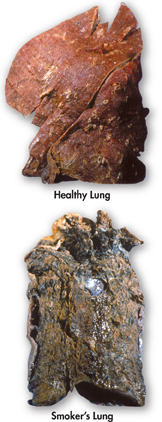Smoking and the Respiratory System
 How does smoking affect the respiratory system?
How does smoking affect the respiratory system?
The upper respiratory tract filters out many particles that could damage the lungs. But some particles and certain kinds of chemicals can bypass those defenses, enter the lungs, and cause serious problems.  Chemicals in tobacco smoke damage structures throughout the respiratory system and have other negative health effects, too.
Chemicals in tobacco smoke damage structures throughout the respiratory system and have other negative health effects, too.
Effects on the Respiratory System Three of the most dangerous substances in tobacco smoke are nicotine, carbon monoxide, and tar. Nicotine is an addictive stimulant that increases heart rate and blood pressure. Carbon monoxide is a poisonous gas that blocks hemoglobin from binding with oxygen, thus interfering with oxygen transport in blood. Tar contains at least 60 compounds known to cause cancer.
Tobacco smoke also paralyzes cilia in the trachea. With the cilia out of action, inhaled particles stick to the walls of the respiratory tract or enter the lungs, and smoke-laden mucus is trapped along the airways. Irritation from accumulated particles and mucus triggers a cough—called a smoker's cough—to clear the airways. Smoking also causes the lining of the respiratory tract to swell, which reduces airflow to the alveoli.

FIGURE 33–18 Effect of Smoking on Lungs Chemicals in cigarette smoke damage cilia in the lungs. Over time, particles build up and lead to respiratory diseases such as chronic bronchitis, emphysema, and lung cancer. The damage that smoking can cause to lungs is visible in the bottom photograph.
Diseases Caused by Smoking Damage to the respiratory system from smoking can become permanent and lead to diseases such as chronic bronchitis, emphysema, and lung cancer. Only 30 percent of male smokers live to age 80, but 55 percent of male nonsmokers live to that age. Clearly, smoking reduces life expectancy. The effect of smoking on the lungs can be seen in Figure 33–18.
▸ Chronic Bronchitis In chronic bronchitis, the bronchi become inflamed and clogged with mucus. Smoking even a moderate number of cigarettes on a regular basis can produce chronic bronchitis. Affected people often find simple activities, like climbing stairs, difficult. Treatments can control symptoms, but there is no cure.
▸ Emphysema Long-term smoking can lead to emphysema (em fuh SEE muh). Emphysema is the loss of elasticity and eventual breakdown of lung tissue. This condition makes breathing difficult. People with emphysema cannot get enough oxygen to the body tissues or rid the body of excess carbon dioxide. There is no cure for emphysema, but it can be treated with medication.
▸ Lung Cancer Lung cancer is particularly deadly because, by the time it is detected, it usually has spread to other areas of the body. Few people diagnosed with lung cancer live more than five years. About 87 percent of lung cancer deaths are due to smoking.
Table of Contents
- Formulas and Equations
- Applying Formulas and Equations
- Mean, Median, and Mode
- Estimation
- Using Measurements in Calculations
- Effects of Measurement Errors
- Accuracy
- Precision
- Comparing Accuracy and Precision
- Significant Figures
- Calculating With Significant Figures
- Scientific Notation
- Calculating With Scientific Notation
- Dimensional Analysis
- Applying Dimensional Analysis




